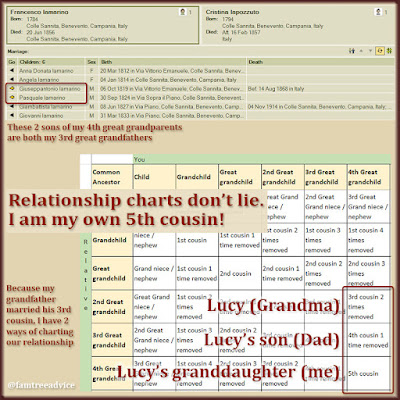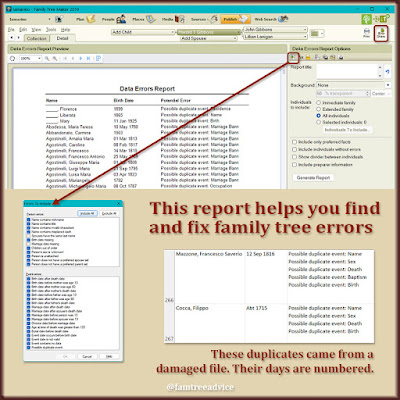Have you seen the meme of Albert Einstein drawing his family tree on a blackboard? He says to himself, "So that would make my second cousin once removed the great aunt of my first cousin twice removed…no, wait, that can't be right."
You know what? He's actually onto something. If you follow the rules, and ignore your known connection to someone, things can get weird.
My father's parents had the same unusual last name—Iamarino. We never gave it much thought. But once I got interested in genealogy, I wanted to know if they had a connection. It turns out my grandparents, Pietro and Lucy Iamarino, were 3rd cousins.
 |
| The dotted line around one instance of Francesco and Cristina tells me they're in my family tree twice. |
Pietro and Lucy's shared 2nd great grandparents appear twice in my ancestor chart. They appear on Grandpa Pietro's line and on Grandma Lucy's line.
If we apply relationship rules to my family, Grandpa Pietro's 3rd cousin (Grandma Lucy) is my 3rd cousin twice removed (3C2R). My 3C2R's son (Dad) is my 4C1R. And I'm my own 5th cousin!
A Scientific Experiment to Prove the Theory
To test out this idea, I searched my family tree for another one of Grandpa Pietro's 3rd cousins. I chose a different set of his 2nd great grandparents. Then I clicked my way down 5 generations to one of their 2nd great grandchildren, Domenico.
Family Tree Maker correctly tells me Domenico is my 3C2R and his daughter is my 4C1R. So, if you put aside that fact that Grandpa Pietro married his 3rd cousin Grandma Lucy, Lucy would be my 3C2R. And her son (Dad) would be my 4C1R. Dad's children (like me) would be my 5th cousin. And my kids would be my 5C1Rs!
And that's when Albert Einstein's mind was blown. Don't you think "I am my own 5th cousin" should be my new email signature?
 |
| Cousins marrying cousins adds a new level of mind-blowing relationships to a family tree. |
Applying the Lesson to DNA Matches
Aside from the fact that it's funny, I bring this up for a more practical reason. We see that different interpretations of a relationship can co-exist. Doesn't this help make sense of some DNA relationships?
I'm looking at one DNA match in my list. Ancestry DNA says she's most likely my 4th–6th cousin. But I know where she fits in my family tree, and she's my 3C2R. There's another, closer relative in my list. I know she is my 3rd cousin, but again, Ancestry DNA says she's most likely my 4th–6th cousin.
We know DNA passes down randomly from generation to generation. Even full siblings can have very different mixtures of their shared ancestors' DNA. Each of your DNA matches has a laundry list of possible relationships to you.
Look beyond the labels your DNA website uses to the groupings they use. Ancestry DNA groups your matches as:
- Parent/Child (both my parents tested, so I see them in this group)
- Close Family (this group includes my 1st and 2nd cousins, plus Dad's 1st cousin and her children)
- Extended Family (these range from Mom's 2nd cousin to Dad's 3rd cousin, and even a 5C1R with multiple connections to me)
- Distant Family (this is where I see the 3C and 3C2R I mentioned above, plus every other relationship under the sun)
Many people in your family tree can have multiple relationships to you. What really matters to you is where they fit in the tree. Don't get hung up on the labels.
Do you have ancestors who married a cousin? What does that make you to yourself?
And speaking of crazy relationships:




